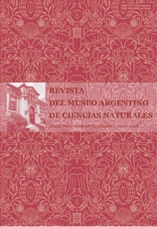Permian glossopterid scale leaves from the La Golondrina Formation (Santa Cruz, Argentina): the neglected members of Glossopteris floras
Resumen
Glossopterid scale leaves from the La Golondrina Formation are described and analyzed. Three different
types are recognized based on their morphological differences and venation patterns. Type A scale leaves are
triangular in shape, have central veins running straight to the apex, and lateral veins dichotomizing once or twice
before reaching the margins. Type B scales have wide-ranging shapes, and a number of separate, central veins
running straight upwards, dividing and anastomosing several times, while lateral veins arch towards the margin,
forming meshes that become shorter and numerous closer to the margins. Last, Type C scale leaves are triangular
to rhombic, sometimes subcircular, convex scales, furrowed by straight, sub-parallel veins that arise from the
base and reach the distal margin, occasionally dichotomizing closer to the margins. The lower and middle parts
of these scales are covered by rounded, small punctuations. The artificial classification here proposed is solely for
the purpose of identification of these elements, and do not necessarily imply relationships. The different types of
scales could have acted as protection of buds and/or fertile parts or as disperser of the latter once they were ripe.
types are recognized based on their morphological differences and venation patterns. Type A scale leaves are
triangular in shape, have central veins running straight to the apex, and lateral veins dichotomizing once or twice
before reaching the margins. Type B scales have wide-ranging shapes, and a number of separate, central veins
running straight upwards, dividing and anastomosing several times, while lateral veins arch towards the margin,
forming meshes that become shorter and numerous closer to the margins. Last, Type C scale leaves are triangular
to rhombic, sometimes subcircular, convex scales, furrowed by straight, sub-parallel veins that arise from the
base and reach the distal margin, occasionally dichotomizing closer to the margins. The lower and middle parts
of these scales are covered by rounded, small punctuations. The artificial classification here proposed is solely for
the purpose of identification of these elements, and do not necessarily imply relationships. The different types of
scales could have acted as protection of buds and/or fertile parts or as disperser of the latter once they were ripe.
Texto completo:
PDFEnlaces refback
- No hay ningún enlace refback.

This work is licensed under a Creative Commons Attribution 3.0 License.

